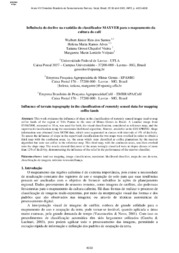Influência do declive na exatidão do classificador MAXVER para o mapeamento da cultura do café.
Influência do declive na exatidão do classificador MAXVER para o mapeamento da cultura do café.
Author(s): SANTOS, W. J. R. dos; ALVES, H. M. R.; VIEIRA, T. G. C.; VOLPATO, M. M. L.
Summary: This work evaluates the influence of slope in the classification of remotely sensed images used to map coffee lands of the region of Três Pontas in the state of Minas Gerais in Brazil. A Landsat image from 07/16/2008, restaured to 10 m, was used for both, the visual classification, considered as reference map, and the supervised classification using the maximum likelihood algorithm, Maxver, available in the GIS SPRING. Slope information was obtained from SRTM data, which were segmented in classes with intervals of 4% of declivity. To assess the influence of slope in the supervised classification the two maps were overlaid in order to obtain a third map with the confusion areas, i.e. the areas which were classified as coffee plantations by the maxver algorithm but were not coffee in the reference map. This third map, with the confusion areas, was then overlaid onto the slope map. The results showed that most of the areas wrongly classified were at slopes classes of more than 12% of declivity, demonstrating the influence of the relief in the performance of the maxver classifier.
Publication year: 2009
Types of publication: Paper in annals and proceedings
Unit: Embrapa Coffee
Observation
Some of Embrapa's publications are published as ePub files. To read them, use or download one of the following free software options to your computer or mobile device. Android: Google Play Books; IOS: iBooks; Windows and Linux: Calibre.
Access other publications
Access the Agricultural Research Database (BDPA) to consult Embrapa's full library collection and records.
Visit Embrapa Bookstore to purchase books and other publications sold by Embrapa.

